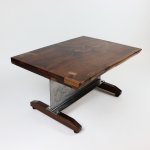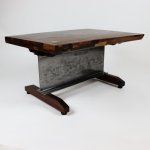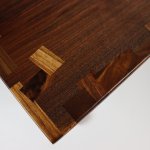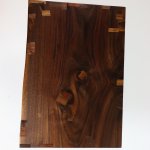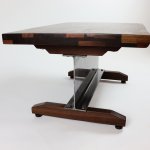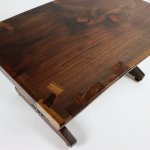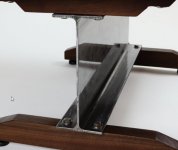rvieceli
Member
Thought I'd show off a project I finished up and photographed recently.
Coffee table made from salvaged steel and locally sourced American black walnut.
The single slab walnut top has a live edge on one side and measures 32 inches wide by 23.5 inches deep and 1.75 inches thick. A series of inlays are used to repair knots and flaws in the slab top and bottom.
The base incorporates a piece of salvaged structural steel H beam. The beam is 25.5 inches long by 10 inches tall and has 4-inch flanges top and bottom. The steel beam is clear coated. All fasteners are stainless steel.
The walnut feet, angled at each end, are 1.5 inches wide, 2.25 inches tall and 18 inches long, providing a stable stance. Each foot is equipped with adjustable leveling mounts.
The table support arms are also walnut, 1.25 inches wide, 2 inches tall and 15 inches long. The supports are slotted where they are bolted to threaded inserts in the top to allow for seasonal wood movement.
The walnut is finished with a low VOC hard wax oil.
The table is 32 inches wide by 23.5 inches deep and stands 16.5 inches tall.
Ron
[attachimg=1]
[attachimg=2]
[attachimg=3]
[attachimg=4]
[attachimg=5]
[attachimg=6]
[attachimg=7]
Coffee table made from salvaged steel and locally sourced American black walnut.
The single slab walnut top has a live edge on one side and measures 32 inches wide by 23.5 inches deep and 1.75 inches thick. A series of inlays are used to repair knots and flaws in the slab top and bottom.
The base incorporates a piece of salvaged structural steel H beam. The beam is 25.5 inches long by 10 inches tall and has 4-inch flanges top and bottom. The steel beam is clear coated. All fasteners are stainless steel.
The walnut feet, angled at each end, are 1.5 inches wide, 2.25 inches tall and 18 inches long, providing a stable stance. Each foot is equipped with adjustable leveling mounts.
The table support arms are also walnut, 1.25 inches wide, 2 inches tall and 15 inches long. The supports are slotted where they are bolted to threaded inserts in the top to allow for seasonal wood movement.
The walnut is finished with a low VOC hard wax oil.
The table is 32 inches wide by 23.5 inches deep and stands 16.5 inches tall.
Ron
[attachimg=1]
[attachimg=2]
[attachimg=3]
[attachimg=4]
[attachimg=5]
[attachimg=6]
[attachimg=7]

